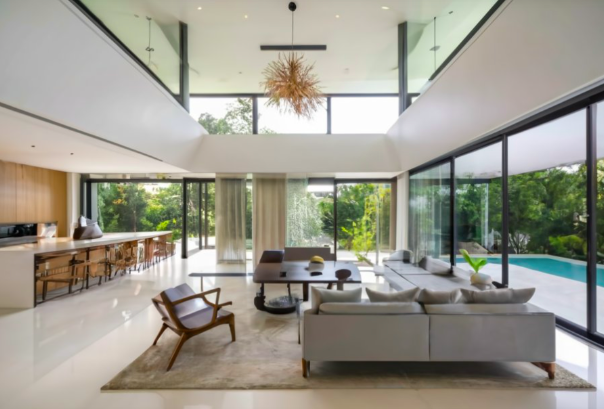Stepping into the Modern Marvel: Unveiling the Elements of Contemporary House Design
The contemporary house design movement embodies a modern aesthetic focused on clean lines, open spaces, and a seamless connection with nature. It’s a style that prioritizes functionality, light, and creating a harmonious living environment. This comprehensive guide delves into the defining characteristics of contemporary house design, empowering you to understand the essence of this architectural style and its potential impact on your life.
The Allure of the Modern: Significance and Impact
Contemporary house design transcends mere aesthetics. It’s a philosophy that reflects a desire for a simpler, more connected way of living. Here’s why this approach to design is gaining traction:
- Embracing Functionality: Contemporary design prioritizes functionality, ensuring every element in the house serves a purpose and contributes to a comfortable and efficient living space.
- Promoting Connection and Light: Open floor plans and an emphasis on natural light foster a sense of connection and spaciousness, allowing for a more vibrant and interactive living environment.
- Sustainability at the Forefront: Contemporary design often incorporates eco-friendly materials and construction practices, promoting environmental responsibility and creating a healthier living space.
Key Features: Unveiling the Hallmarks of Contemporary Style
Several key features define the contemporary house design aesthetic:
A. Open Floor Plans: Walls are strategically removed to create large, open living areas that seamlessly connect the kitchen, dining room, and living room. This fosters a sense of spaciousness, promotes interaction, and allows for an abundance of natural light to flow throughout the space.
B. Natural Light as a Design Element: Large windows, skylights, and strategically placed light sources bathe contemporary houses in natural light. This not only reduces reliance on artificial lighting but also creates a bright and airy atmosphere that connects the indoors to the outdoors.
C. Minimalist Design: Contemporary design embraces minimalism, focusing on clean lines, uncluttered spaces, and a lack of unnecessary ornamentation. This creates a sense of order, serenity, and allows the beauty of the architectural elements and natural light to take center stage.
D. Seamless Indoor-Outdoor Living: Contemporary houses often blur the lines between indoor and outdoor spaces. Large sliding glass doors, expansive decks, and strategically placed patios create a seamless flow between the living space and the surrounding environment, fostering a connection with nature.
E. Sustainable and Environmentally-Friendly Elements: Contemporary design is increasingly eco-conscious. This can involve using recycled materials, incorporating energy-efficient appliances and systems, and strategically designing for natural ventilation and light.
Material Matters: The Look and Feel of Contemporary Finishes
The materials used in contemporary house design play a crucial role in defining the overall aesthetic:
A. The Allure of Glass and Steel: Glass and steel are often prominent features, offering a sleek and modern look. Large glass windows allow for natural light penetration, while steel can be used for structural elements, railings, or even doors, creating a sense of openness and strength.
B. Celebrating Nature’s Beauty: Natural materials like wood, stone, and concrete are frequently incorporated, adding warmth and texture to the contemporary aesthetic. Exposed wood beams, stone countertops, or polished concrete floors create a connection with nature and add a touch of organic beauty.
C. Neutral Color Palettes: Neutral color palettes like white, beige, and gray dominate contemporary design. These colors provide a clean and sophisticated backdrop that allows for the architectural elements and pops of color from artwork or furniture to take center stage.
D. Statement Fixtures and Elements: While minimalism reigns supreme, contemporary design allows for the incorporation of statement fixtures or unique elements. This could include a sculptural light fixture, a bold splash of color on an accent wall, or a custom-designed fireplace that becomes a focal point of the space.
Architectural Elements: Shaping the Modern Silhouette
The architectural features of contemporary houses contribute significantly to their unique style:
A. Clean Lines and Geometric Shapes: Clean lines and geometric shapes are a hallmark of contemporary design. This can be seen in the rectangular or cubic forms of the house itself, the straight lines of windows and doors, and the overall emphasis on simplicity and order.
B. Flat Roofs: Flat roofs are a common feature in contemporary houses, contributing to the clean and modern aesthetic. They can also be utilized for rooftop gardens or solar panels, further enhancing the connection with nature and promoting sustainability.
C. Unique Facades and Exterior Finishes: While clean lines dominate, contemporary house design allows for variations in facade treatments. This can involve using a combination of materials like wood and stone, incorporating textured finishes, or creating unique geometric patterns on the exterior walls.
D. Integration of Technology: Contemporary houses often embrace smart home technology. This can include automated lighting systems, security features, and climate control systems, offering convenience, security, and increased energy efficiency.
Stepping Inside: Unveiling the Interior Design Language of Contemporary Homes
The interior design of contemporary houses follows a similar philosophy as the exterior, with a focus on functionality, clean lines, and creating a comfortable and stylish living environment. Let’s explore some key trends:
A. Simple and Functional Furnishings: Furniture in contemporary spaces is often clean-lined, functional, and low-profile. This minimizes clutter and emphasizes the open floor plan. Look for sleek sofas, minimalist coffee tables, and chairs with uncluttered designs.
B. Integration of Technology in Home Automation: As mentioned earlier, technology plays a significant role in contemporary design. Smart home systems allow for control of lighting, temperature, security, and even entertainment systems through voice commands or mobile apps, enhancing convenience and comfort.
C. Incorporation of Art and Statement Pieces: While minimalism reigns supreme, contemporary interiors don’t shy away from incorporating statement pieces. This could be a bold work of art, a unique sculpture, or a designer piece of furniture that adds personality and a touch of luxury to the space.
D. Sustainable and Eco-Friendly Interior Features: Sustainability extends beyond the construction materials. Look for eco-friendly furniture made from recycled materials, energy-efficient appliances, and LED lighting to create a healthy and environmentally conscious living environment.
Nature’s Embrace: Landscape Design in Contemporary Homes
Landscape design plays a crucial role in tying the contemporary house to its surroundings:
A. Minimalist Landscaping: The landscaping surrounding a contemporary house often reflects the minimalist aesthetic. Clean lines, geometric shapes, and low-maintenance plants are popular choices. This creates a cohesive look and complements the clean lines of the house.
B. Sustainable and Native Plantings: Sustainable practices extend to the landscaping. Native plants that require minimal watering and are adapted to the local climate are often favored. This promotes biodiversity, reduces maintenance needs, and conserves water.
C. Outdoor Living Spaces and Entertaining Areas: Outdoor living spaces are integral to contemporary design. Patios, decks, and terraces seamlessly connect the interior to the exterior, creating areas for relaxation, entertaining, and enjoying the outdoors.
D. Seamless Integration with Interior Spaces: The connection between indoor and outdoor spaces goes beyond just access. Sliding glass doors, retractable walls, and strategically placed windows blur the lines between interior and exterior, creating a sense of spaciousness and a constant connection with nature.
A Glimpse into Modern Living: Case Studies of Contemporary Design
To truly understand the essence of contemporary design, let’s explore some real-world examples:
A. Showcase of Contemporary Houses:
- The Walker Residence by Marmol Radziner: This California residence exemplifies the open floor plan concept, with expansive glass walls and a seamless flow between the living areas and the surrounding landscape.
- The Cloud House by FORM architects: This stunning house in Chile features a unique, curved roof and a cantilevered design, showcasing the innovative use of form in contemporary architecture.
- The Stepping Stone House by Sanjay Puri Architects: Located in India, this house incorporates traditional materials like stone with a modern luxury interior design, demonstrating a successful blend of contemporary and regional aesthetics.
B. Analysis of Design Elements and Features: Analyzing these case studies allows us to see how key features like clean lines, natural light utilization, sustainable materials, and integration of indoor-outdoor spaces come together to create unique and functional living environments.
C. Impact on Lifestyle and Well-being: Contemporary design promotes a connection with nature, fosters a sense of spaciousness and light, and creates a focus on functionality and well-being. This approach to living can positively impact residents’ physical and mental health, encouraging relaxation and a more connected lifestyle.
Conclusion: Embracing the Modern Marvel
Contemporary house design offers a unique approach to creating a stylish and functional living environment. It prioritizes clean lines, natural light, a seamless connection with nature, and the use of sustainable materials and practices. By understanding the key features, materials, and architectural elements of contemporary house design, you can make informed decisions about your own living space, whether you’re building a new home or renovating your existing one.
The future of contemporary design is likely to see further integration of technology, a continued focus on sustainability, and even more innovative uses of materials and forms. As technology evolves and our understanding of environmental responsibility grows, contemporary design will undoubtedly continue to adapt and redefine modern living. Contact MRD today to schedule a consultation and start transforming your home into a space that you love.



